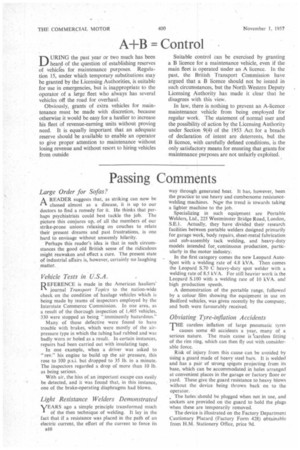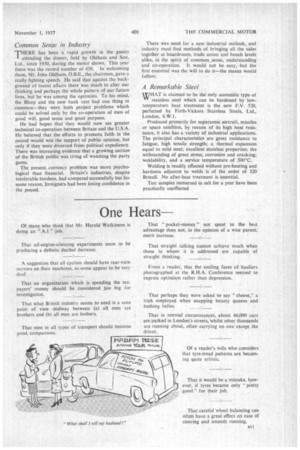Passing Comments
Page 44

Page 45

If you've noticed an error in this article please click here to report it so we can fix it.
Large Order for Sofas?
AREADER suggests that, as striking can now be classed almost as a disease, it is up to our doctors to find a remedy for it. He thinks that perhaps psychiatrists could best tackle the job. The picture this conjures up, of all the members of our strike-prone unions relaxing on couches to relate their present dreams and past frustrations, is one hard to envisage without unseemly hilarity.
Perhaps this reader's idea is that in such circumstances the good old British sense of the ridiculous might reawaken and effect a cure. The present state of industrial affairs is, however, certainly no laughing matter.
Vehicle Tests in U.S.A.
REFERENCE is made in the American hauliers' journal Transport Topic's to the nation-wide check on the condition of haulage vehicles which is being made by teams of inspectors employed by the Interstate Commerce Commission. In one area, as a result of the thorough inspection of 1,405 vehicles, 330 were stopped as being "imminently hazardous."
Many of those defective were found to have trouble with brakes, which were mostly of the airpressure type in which the tubing had rubbed and was badly worn or holed as a result. In certain instances, repairs had been carried out with insulating tape.
In one example, when a driver was asked to " rev." his engine to build, up the air pressure, this rose to 100 psi. but dropped to 35 lb. in a minute. The inspectors regarded a drop of more than 10 lb. as being serious.
With air, the hiss of an important escape can easily be detected, and it was found that, in this instance, one of the brake-operating diaphragms had blown.
Light Resistance Welders Demonstrated
VEARS ago a simple principle transformed much
I of the then technique of welding. It lay in the fact that if a resistance was placed in the path of an electric current, the effort of the current to force its
alO way through generated heat. It has, however, been the practice to use heavy and cumbersome resistancewelding machines. Noy,/ the trend is towards taking a lighter machine to the job.
Specializing in such equipment are Portable Welders, Ltd., 225 Westminster Bridge Road, London, S.E.1. Actually, they have divided their research facilities between portable welders designed primarily for garage work, body repairs, sheet-metal fabrication and sub-assembly tack welding, and heavy-duty models intended for, continuous production, particularly in the motor industry.
In the first category comes the new Leopard AutoSpot with a welding rate of 4.8 kVA. Then comes the Leopard S.70 C heavy-duty spot welder with a welding rate of 8.5 kVA. For still heavier work is the Leopard S.100 with a welding rate of 10 kVA. and high production speeds.
A demonstration of the portable range, followed by a colour film showing the equipment in use on Bedford vehicles, was given recently by the company, and both were favourably received.
Obviating Tyre-inflation Accidents
careless inflation of large pneumatic tyres causes some 40 accidents a year, many of a serious nature. The main cause is 'careless fitting of the rim ring, which can then fly out with considerable force.
Risk of injury from this cause can be avoided by using a guard made of heavy steel bars. It is welded and has a pair of strong spigots projecting from its base, which can be accommodated in holes arranged at convenient places in the garage or factory floor or yard. These give the guard resistance to heavy blows without the device being thrown back on to the operator.
The holes should be plugged when not in use, and sockets are provided on the guard to hold the plugs when these are temporarily removed.
The device is illustrated on the Factory Department Cautionary Placard (Factory Form 428) obtainable from H.M. Stationery Office, price 9d.
Common Sense in Industry
THERE has been a rapid growth in the guests attending the dinner, held by Oldham and Son. Ltd., since 1930, during the motor shows: This year there was the record number of 450. In welcoming them, Mr. John Oldham, 0.B.E., the chairman, gave a really fighting speech. He said that against the background of recent affairs there was much to alter our thinking and perhaps the whole pattern of our future lives, but he was among the optimists. To his mind, the Bleep and the new bank rate had one thing in common—they were both project problems which could be solved only by the co-operation of men of good will, good sense and good purpose.
He had hopes that they would now see greater technical co-operation between Britain and the U.S.A. He believed that the efforts to promote faith in the pound would win the support of public opinion, but only if they were divorced from political expediency. There was increasing evidence that a growing section of the British public was tiring of watching the party game.
The present, currency problem was more psychological than financial. Britain's industries, despite intolerable burdens, had competed successfully but for some reason, foreigners had been losing confidence in the pound. There was need for a new industrial outlook, and industry must find methods of bringing all the sides together at boardroom, trade union and bench levels alike, in the spirit of common _sense, understanding and co-operation. It would not be easy, but the first essential was the will to do it—the means would follow.
A Remarkable Steel
wHAT is claimed to be the only austenitic type of vv stainless steel which can be hardened by lowtemperature heat treatment is the new F.V. 520, perfected by Firth-Vickers Stainless Steels, Ltd.,. London, S.W.1.
Produced primarily for supersonic aircraft, missiles or space satellites, by reason of its high heat resistance, it also has a variety of industrial applications. The principal characteristics are great resistance to fatigue; high tensile strength; a thermal expansion equal to mild steel; excellent stainless properties: the withstanding of great stress, corrosion and cracking, weldability, and a service temperature of 500°C.
Welding is readily effected without pre-heating and hardness adjacent to welds is of the order of 320 Brinell. No after-heat treatment is essential.
Test samples immersed in salt for a year have been practically unaffected
























































































































